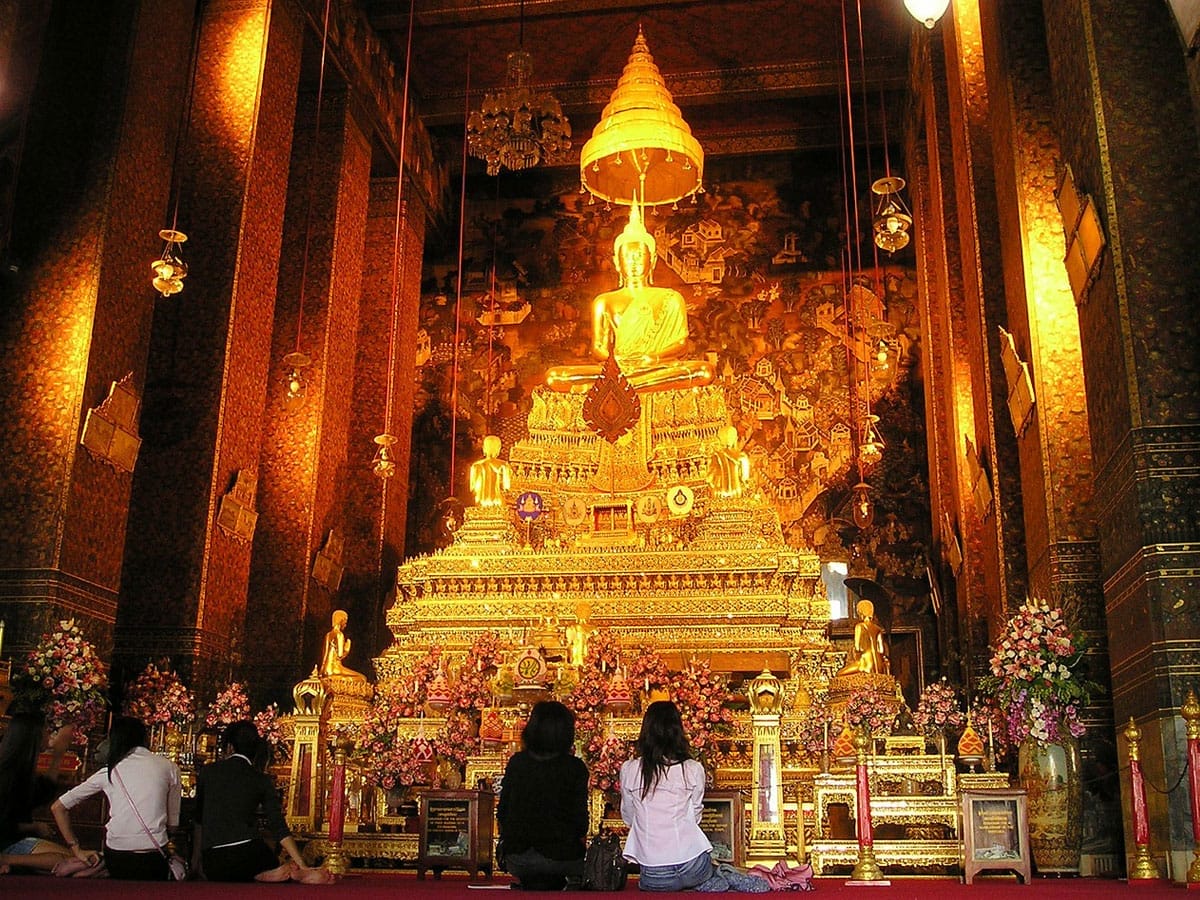Do Shamanism Beliefs and Other Religious Beliefs Mix?
Shamanism as a Container
Unlike organized religions that tell you exactly what to believe, precisely when to worship, and literally how to talk to God, the practice of shamanism does not fill our worlds with things to do and think.
I like to use the metaphor of a container, be it a bowl, vase, or basket, that holds our beliefs. Shamanism is that bowl. It is our hands cupped and open, ready to receive whatever we choose to fill them with. This reality is refreshing for many people who are looking to break free from the confines of an organized religion that no longer fits what they believe, but who do not want to leave everything behind.
Shamanism is a worldview, meaning a way of seeing the structure of the cosmos. Shamanism beliefs tell us how the world is ordered and connected. We learn early on in shamanic studies that the cosmos is made up of three worlds: lower, middle and upper. These three worlds are connected by a central axis, also known as the axis mundi, world axis or cosmic axis.
This belief in the basic structure of the universe leaves a lot to the imagination, and that is where other religious beliefs come in to fill the container.
This motif of the three worlds and connecting axis mundi is common throughout all shamanic cultures. Of course, each tradition elaborates on the theme adding levels to each world and/or preferring one axis over another. What fills these three worlds also varies widely depending on the local religious beliefs. In polytheistic groups that believe in many gods, there are gods and goddesses that move throughout the worlds, some laying claim to one world or another. In monotheistic traditions, one God is infused throughout and influences all of the worlds.
Shamanism Beliefs & Christianity
Most people know that shamanism and Christianity have historically been at odds. Although not the only establishment hunt witches, the Catholic church was famous for naming shamans as witches and sorcerers. As a result, many shaman were burned at the stake for their beliefs and practices. If you feel these two paths are incompatible, history is on your side.This rift between the traditions is only recently healing in the hearts and minds of individuals who follow the teachings of Christ and benefit from shamanic practices.
The age-old trouble between Christian churches and shamanic practitioners assuredly has a number of roots that fill many volumes, but we can view it simply as the clash between the need for centralized power and the desire to place power in the hands of the community.
In traditional shamanic cultures, belief was much less centralized and the shaman had a good deal of authority and influence over the spiritual lives of community members. People trusted their shamans and knew them well, this pulled them away from organized churches which was an obvious threat to the church. But, this is just politics after all. Let’s get back to beliefs.
The toughest conflict in beliefs to reconcile between Christianity and shamanism is in regards to what lies beneath us. Shamans travel to lower world by going down through the earth, and they have beautiful, healing experiences. Christians believe that hell is below us and would never dare to imagine venturing below the earth’s crust. Anyone who is a Christian practicing shamanic techniques has to forfeit their belief that hell is the only thing below us.
What shamanism and Christianity do have in common is a shared belief that there is both good and evil. Exorcism and depossession are practiced both within Christian faith and shamanic tradition.
The belief in a single God and the belief that Christ is our savior do not come into conflict with shaman beliefs. In fact, they blend quite nicely into shamanic tradition. I know a number of Catholics, Protestants, Lutherans, etc. that incorporate shamanism into their involvement with an organized Christian theology. I myself follow the teachings of Catholic mystics and find these teachings support a lot of what I experience in my shamanic practice.
Shamanism & Buddhism
As I mentioned in a previous article, shamanism and Buddhism have a lot in common. The belief that all of life is interconnected is paramount for both systems. They are both forms of eco-spirituality and neither depend solely on the existence of a God or gods.
Buddhists focus on the workings of the mind and how to release thoughts and attachments. Shamanists believe that thoughts are energy and that thoughts have a profound effect on our world. Shamans are taught how to watch the movement of energy. In shamanism, the study of attachments is common and shamanic practitioners learn how to break attachments.
Buddhists are interested in dissolving the ego. Shamans endeavor to become a “hollow bone” or “hollow reed” to be a clear channel for healing energy. Ego gets in the way of the healing. Thus, shamans are also interested in dissolution of the ego. As you can see, there are many ways that these two belief systems compliment each other quite nicely.
Shamanism & Atheism
Like Atheism, shamanism does not require belief in any particular deity or deities. However, it does require the belief of spirits and a spirit world. The belief that we have souls and the acceptance of the movement of energy in the hidden realms are essential and basic components of shamanic practice. This may or may not be an issue for some atheists depending on how strictly they’ve diverged from traditional religious convictions.
Shamans work to understand mystical laws so that they can understand the processes of illness and healing. Shamans also study the movement of harmful and compassionate acts in relation to illness and advise others on ethical behavior. Similarly, atheists often find some form of ethical code to follow and are interested in the cause and effect workings of the universe. In this way, the two perspectives inform one another.
Shamanism & Paganism
Paganism is a natural fit for shamanism and many of the beliefs in these traditions are the same. Paganism arose from hunter-gatherer cultures at the same time and in cooperation with shamanism. Paganism can easily be viewed as the lay-person religion in communities that had the shamans as religious leaders. This does not mean that all shamans are pagans and vice versa. The two can be practiced independently and do not rely on each other to exist.
Shamanism Beliefs & Other Religions
Obviously, this is not an exhaustive comparison of shamanic beliefs and other religious beliefs, but, suffice it to say that shamanism can be studied and practiced in collaboration with many additional faiths including Hinduism, Judaism and Sufism. Please share your experiences below of how you’ve combined your religious beliefs with your shamanic practice.
About Author, Stacey L. L. Couch
 Stacey L. L. Couch, Certified Shamanic Practitioner, works as a publicist and journalist for Mother Nature and is the author of Gracious Wild: A Shamanic Journey with Hawks. She empowers people with the ability to explore life’s big questions by calling on nature, story and synchronicity as a source for guidance and healing. With her deeply rooted experience in the field of shamanism and passion for working with wildlife and rescue animals, Stacey has a unique blend of rational and mystical perspective that makes the world of shamanism easily accessible to others. She values mindfulness, wonder, and compassion in her daily spiritual practice. Learn More about Stacey.
Stacey L. L. Couch, Certified Shamanic Practitioner, works as a publicist and journalist for Mother Nature and is the author of Gracious Wild: A Shamanic Journey with Hawks. She empowers people with the ability to explore life’s big questions by calling on nature, story and synchronicity as a source for guidance and healing. With her deeply rooted experience in the field of shamanism and passion for working with wildlife and rescue animals, Stacey has a unique blend of rational and mystical perspective that makes the world of shamanism easily accessible to others. She values mindfulness, wonder, and compassion in her daily spiritual practice. Learn More about Stacey.












[…] Source: Do Shamanism Beliefs and Religion Mix? […]
Yes, I believe it is possible to mix shamanism with other religions. Personally, I have mixed my shamanic practice with these teachings for 25 years and it works great.
Thank you for sharing your experience Mandra! This is one of the top reasons why I love shamanism because it blends well with one or many belief systems.
Stacey,
I love your post. I am drawn to shamanism, and I recently had a beautiful experience of merging with a hawk during a meditation. I will have to check out your book and online classes. I recently wrote a post about how I am informed by many different beliefs including shamanism after my NDE. https://triciabarkernde.com/2016/08/09/spiritual-identity-mixing-spiritual-beliefs/
I look forward to reading more from you.
Tricia
Hello Tricia, It is lovely to meet you! I enjoyed reading your post as well. It seems we agree on many levels about the mixture of beliefs. I look forward to staying in touch and sharing ideas. Many Blessings, Stacey
Hello Stacey
I found your comments about Shamanism and Christianity helpful – 18 months ago I consulted a nutritionist who also practices as a homeopath and a shamanic practitioner – she suggested shamanic healing but although I started reading her suggested book – Singing the Soul Back Home – I was afraid and felt the practice was incompatible with my Christian beliefs. However I reached a point of desperation recently and it was suggested that I look at this again, which I did a week ago with some apprehension, but it all made sense and re-reading the above book I now wonder why I was afraid. I attended a workshop last weekend and believe I eventually journeyed myself for the first time – opens exciting possibilities and when I can find uninterrupted time to myself I am anxious to try this again. One of my problems is that I know I like to remain in control! I am very conscious that I need to cultivate a habit of gratitude – I thanked our ducks for their eggs when I baked a cake and it’s a start. Thank you.
That is a start Susan and a lovely one. Thank you for sharing your decision making process with us. It can be very hard to integrate multiple faiths especially when they seem in conflict. It is adventurous territory you’re walking into and I applaud your courage and pioneering spirit. Remember to carry your prayer practice with you. That along with a habit of gratitude will help you face the fears of losing control. I am here to help you navigate this passage and help you with your personal journeying practice should you need additional support. Many Blessings, Stacey
i think that i have had many journeys i had a memorable one when i was young were i left my my body and i was nothing in relation with faith but i do believe in druids and their beliefs i have had dreams that were nore real than the waking world in them i was always helping people and most of the time i was an authority and i meditate on ocation
Yes Jack, dreams are forms of journeys too. The invisible world is just as real as this one. Thanks for having the courage to explore the mystery!
I think both practice makes one in more control of your mind which leads to better life with your intention
I have struggled with being a Christian and starting a walk in the unknown. But for years I have had dreams, signs and I turn away from them. Recently I met someone who believes that I have a gift. One night while I was meditating I found shamanic drumming and I don’t know there is something soothing about the drums that puts me at ease. But as a Christian I struggle with combining my faith and my gifts. I was always taught from a young age that any dreams, feelings of empath or a sense of difference was not talked about. But I feel this is the road I am mean’t to be on. The road that unlocks my mind. If anyone can give me some direction that would great.
Kelly, sounds like you have a prophetic gift, which is very Biblical. Look up some of John Paul Jackson’s and Shawn Bolz- they prophesy and interpret dreams. Your gift is God-given!